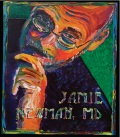The case of the undulant ungulate
A graduate student discovers the dangers of gourmet roadkill.
Sylvia Petersen was excited to be on vacation from graduate school with her new husband and his brother, traveling to their small hometown in Wyoming. They would visit for a month, and then head off on a European honeymoon (without the brother!). It was all she could think about.
Driving their pickup through the snow on a dark country road, they didn't see the yearling elk till it was plastered across the bumper. Rather than allowing the animal to spoil on the side of road, the brothers decided to wrap the carcass in a tarp and load it into the bed of their truck, against Sylvia's objections. Gourmet roadkill for sure.

The brothers drank beer and butchered the elk in their garage, then asked Sylvia cook up some elk roast. She hit the kitchen and several hours later sampled a slice of the meat after determining the dish was nearly ready. It tasted like roadkill. She salted it, tried some hot sauce, but it still tasted like something that had been scraped off the bumper. She dumped it. They had pizza.
A few weeks later, Sylvia presented to the local hospital with a 3-day history of visible left inguinal lymphadenopathy and left lower extremity swelling extending to the level of her hip. She had fever and night sweats, and every joint in her body was on fire. An extensive work-up was performed. Ultrasound was negative for venous thrombosis. She transferred to our hospital. She wasn't as worried about her health as she was about possibly missing her honeymoon.
One hundred and twenty years earlier, Lieutenant David Bruce of the British Royal Army Medical Corps was on his own honeymoon. He had hoped to be posted in South Africa, to hunt something smaller than the big game that interested most of his peers. He wanted to hunt microbes in exotic locations. Despite his wishes, he was posted in the decidedly less exotic location of the British Garrison at Malta. Luckily for him, though not for the garrison, there was a febrile disease waiting for him there. He soon acquired several patients who complained of a similar set of symptoms: fevers in excess of 41 degrees Celsius that would dissipate over the course of a day, only to recur in a cyclical fashion. The course of this illness, known as “Malta fever,” would last several months and the outcomes were occasionally fatal.
Dr. Bruce set up a laboratory with his wife, barely knowing how to do so. He taught himself to make plates out of beef broth and agar. In 1886, they isolated a coccobacillus from the spleen of a man who had died as a result of the malady. He originally named this bacteria “Micrococcus melitensis.” Goat milk consumption and close contact with goats was linked with the human disease. This association allowed the melitensis species to be isolated from these animals in 1905 by a Greek physician working with Dr. Bruce, Themistocles Zammit. Shortly after this, the bacterium also was isolated from cattle (abortus species) and swine (suis species). In the 1920s, the genus was renamed Brucella in honor of its discoverer.
U.S. case descriptions of an illness similar to Malta fever were published in 1911, reporting on a group of goat herders near the Mexican border in Texas who consumed goat milk. Infection in cattle soon became more prevalent than in goats or swine, and the disease became endemic in animals in Iowa and Minnesota, where several human cases appeared in the late 1920s. The human disease was popularly termed “undulant fever” until the 1940s, when the name brucellosis started to catch on. Between 1930 and 1943, there were 36,513 reported cases of human brucellosis in the U.S.
Pasteurization of milk became widespread in the U.S. during the 1920s and protected the general public from brucellosis. However, farmers, veterinarians, and packing plant workers were still being burdened by the condition. In 1941, the first live attenuated vaccine was developed and licensed for use in calves by the U.S. Department of Agriculture.
Today, all dairy herds in the U.S. are tested at least yearly, infected cows are killed, and young cows are required to be vaccinated. Human brucellosis is diagnosed almost exclusively in people who consume unpasteurized dairy products from Mexico or overseas; U.S. case counts have been reduced to about 100 to 200 annually. The only remaining uncontrolled reservoirs of Brucella in the U.S. are elk and bison populations in the greater Yellowstone region. These animals threaten nearby livestock populations with contact and significant efforts are underway to maintain separation.
Sylvia was admitted to our service with a broad differential. A barrage of laboratory tests followed. She had a high sedimentation rate and elevated C-reactive protein. Extensive rheumatological testing was unrevealing. A lymph node excisional biopsy was performed, showing reactive lymphadenopathy negative for acid-fast bacilli and malignancy. Further investigations yielded positive serology for Brucella. The mystery was solved. Sylvia was discharged with a 6-week course of doxycycline and rifampin for treatment of human brucellosis.
As she left the hospital, she was happy. She had a non-fatal diagnosis and could go on her honeymoon. We asked where she was going. She smiled as she told us they were starting at the homeland of her great-grandfather, a small island in Europe called Malta.
The history, facts, and results of this case have been changed to protect patient privacy.



